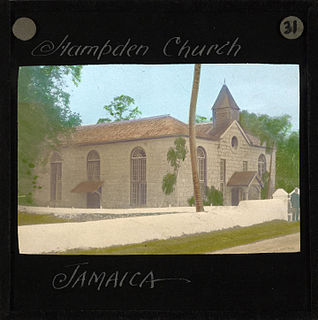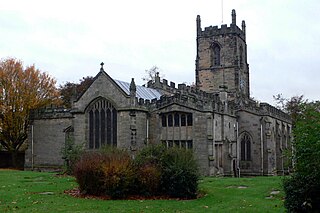
The Moravian Church, formally named the Unitas Fratrum, in German known as [Herrnhuter] Brüdergemeine, is one of the oldest Protestant denominations in the world, with its heritage dating back to the Bohemian Reformation in the 15th century and the Unity of the Brethren established in the Kingdom of Bohemia.

Falmouth is the chief town and capital of the parish of Trelawny in Jamaica. It is situated on Jamaica's north coast 18 miles east of Montego Bay. It is noted for being one of the Caribbean's best-preserved Georgian towns.
E. and G.G. Hook was a pipe organ designing and manufacturing company, located in Boston, Massachusetts, which operated from 1827 to 1935. It was started, and originally run, by brothers Elias and George Greenleaf Hook.

Thomas Burchell (1799–1846) was a leading Baptist missionary and slavery abolitionist in Montego Bay, Jamaica in the early nineteenth century. He was among an early group of missionaries who went out from London in response to a request from African Baptists on the island. He established churches and schools to aid the slaves. Burchell is credited with the concept of Free Villages and encouraging their development by Baptist colleagues such as William Knibb, as well as by other denominations. Anticipating abolition of slavery, he helped raise funds in Great Britain to acquire land for freedmen after they were emancipated, and to develop Free Villages.
The Jamaica Province of the Moravian Church is part of the worldwide Moravian Church Unity.

Protestantism is the dominant religion in Jamaica. Protestants make up just over 60% of the population. The five largest denominations in Jamaica are: Church of God, Seventh-day Adventist, Baptist, Pentecostal and Anglican. The full list is below. most of the Caribbean is Catholic, Jamaica’s Protestantism is a legacy of missionaries that came to the island in the 18th and 19th centuries. Missionaries attempted to convert slaves to varying Protestant denominations of Moravians, Baptists, Methodists, and Presbyterians to name a few. As missionaries worked to convert slaves, African traditions mixed with the religion brought over by Europeans. The Protestant church was associated with black nationalism in Jamaica, aiming to improve the lives of blacks who were governed by a white minority during colonial times. Today, the church plays an important role in society by providing services to people in need.

The Church of the Redeemer is the oldest Moravian Church building in Kingston, Jamaica, and houses a congregation of the Jamaican province of the Moravian Church. It was opened in 1918. The name, which is unusual for a Moravian church, was bestowed by its builder Jonathan Reinke "because he did not want people to speak of Reinke's church".

Bethabara Moravian Church is a congregation of the Jamaica Province of the Moravian Church. It opened for worship on 1841-07-28.

Trinity Moravian church houses a congregation of the Jamaican province of the Moravian Church. It was established in 1954 as part of the bicentenary celebrations of the Moravian Church in Jamaica.
Nils Otto Tank was a Norwegian born, Moravian Church missionary and teacher. He was a pioneer settler in Wisconsin.

Cefn Cribwr is a village and community in Bridgend County Borough in south Wales. The village is located about 5 miles (8 km) from the centre of Bridgend town. It is situated on a ridge between Pyle and Aberkenfig. Cefn Cribwr, as a community, recorded a population of 1,546 in the 2001 Census, reducing to 1,481 at the 2011 Census.

James Phillippo was an English Baptist missionary in Jamaica who campaigned for the abolition of slavery. He served in Jamaica from 1823 to his death, with some periods lobbying in England for funds to support his work on the island. He led the founding of several Free Villages, having gained funds to grant freedmen and their families plots of land for farming in villages independent of planter control. He also wrote and published three books about Jamaica.

All Souls Church, Halifax, is a redundant Anglican church in Haley Hill, Halifax, West Yorkshire, England. It is recorded in the National Heritage List for England as a designated Grade I listed building, and is under the care of the Churches Conservation Trust.

Phillippo Baptist Church, built 1827, is named after its founder and first minister, Reverend James Phillippo, a Baptist missionary who arrived in Jamaica in 1823. He campaigned for the abolition of slavery and for the establishment of "Free Villages" for emancipated slaves. The church is located on the corner of William and French Streets, in Spanish Town, Jamaica.

Plantations are an important aspect of the history of the American South, particularly the antebellum era. The mild subtropical climate, plentiful rainfall, and fertile soils of the southeastern United States allowed the flourishing of large plantations, where large numbers of workers, usually Africans held captive for slave labor, were required for agricultural production.

Plantation complexes in the Southern United States refers to the built environment that was common on agricultural plantations in the American South from the 17th into the 20th century. The complex included everything from the main residence down to the pens for livestock. A plantation originally denoted a settlement in which settlers were "planted" to establish a colonial base. Southern plantations were generally self-sufficient settlements that relied on the forced labor of slaves, similar to the way that a medieval manorial estate relied upon the forced labor of serfs.

St John the Evangelist's Church is the Anglican parish church of the Upper St Leonards area of St Leonards-on-Sea, a town and seaside resort which is part of the Borough of Hastings in East Sussex, England. The present building—a "very impressive and beautifully detailed" church in the Gothic Revival style, with a landmark tower—combines parts of Arthur Blomfield's 1881 church, wrecked during World War II, and Harry Stuart Goodhart-Rendel's 1950s rebuild. Two earlier churches on the site, the second possibly designed by Samuel Sanders Teulon, were themselves destroyed earlier in the 19th century. The rich internal fittings include a complete scheme of stained glass by Goodhart-Rendel's favoured designer Joseph Ledger and a 16th-century painting by Ortolano Ferrarese. English Heritage has listed the church at Grade II* for its architectural and historical importance.

St Helen's Church is the Anglican parish church of Ashby-de-la-Zouch, in the deanery of North West Leicestershire and the Diocese of Leicester. There was a church in the town in the 11th century, but the core of the present building mainly dates from work started in 1474, when the church was rebuilt by William Hastings at the same time that he converted his neighbouring manor house into a castle. The church was refurbished in about 1670 to create more space, but the large and increasing size of the congregation led to further work in 1829, and a major rebuild in 1878–80, including the widening of the nave by the addition of two outer aisles.

New Herrnhut Moravian Church is a historic Moravian church in Saint Thomas, U.S. Virgin Islands. The Moravians, a Protestant religious group based in the town of Herrnhut in Saxony, began missionary work in 1732 in St. Thomas and were the first Protestants to begin missionary work among slaves and free Blacks in the Danish West Indies. Missionary work on St. Thomas was initially opposed by planters who didn't want slaves to receive education or religious instruction.

Jamaica was an English colony from 1655 or 1670, and a British Colony from 1707 until 1962, when it became independent. Jamaica became a Crown colony in 1866.






















